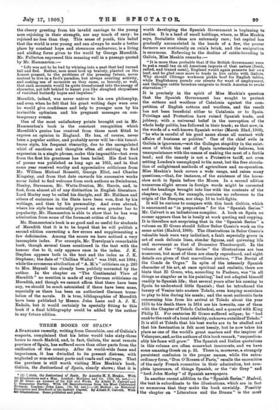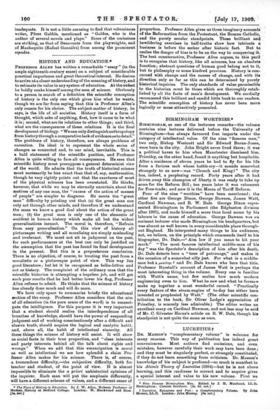THREE BOOKS ON SPAIN.*
A SPANIARD recently, writing from CorcubiOn, one of Galicia's seaports, complained that his letter would take sixty-three hours to reach Madrid, and, in fact, Galicia, the most remote province of Spain, has suffered more than other parts from the unification of the country. After its world-wide fame and importance, it has dwindled to its present distress, with neglected or non-existent ports and roads and railways. That the province is still worth visiting Miss Meakin's book, Galicia, the Switzerland of Spain, clearly shows ; that it is (1) ilteig, the Switzerland of Spain. By Annette M. B. Meakin. With 105 Illustrations and a Map. London : Methuen and Co. [12s. 6d. net.]— (2) Et Greco: an Account of his Life and Works. By Albert F. Calvert and C. Gasquoine Hartley. With 136 Reproductions from his Most Celebrated Pictures. London : John Lane. [3s. firl. net.]—(3) Madrid, an Historical Description and Handbook of the Spanish Capital. By Albert F. Calvert. With 433 Illustrations. Same publisher and price.
worth developing the Spanish Government is beginning to realise. It is a land of small holdings, where, as Miss Meakin says, Socialistic ideas are extremely rare; but capital has gradually accumulated in the hands of a few, the poorer farmers are continually on ruin's brink, and the emigration is enormous. Referring to the decline of cattle-breeding in Galicia, Miss Meakin remarks :—
"it is more than probable that if the British Government were to put a small tax on all American imports of that nature [fresh, salted, and tinned meat], England would again preserve her own beef, and be glad once more to trade in live cattle with Galicia. Why should Chicago workmen pickle beef for English tables, while Englishmen parade our streets for want of employment, and Gallegan cattle breeders emigrate to South America to evade starvation ?"
It is precisely in the spirit of Miss Meakin's question that the Spanish Government has sought to protect the cottons and woollens of Catalonia against the com- petition of English cottons and woollens, and the result has not been beneficial either to Catalonia or to Spain. Privilege and Protection have ruined Spanish trade, and jobbery, with a universal belief in the corruption of the whole body politic, has followed in their track; so that now, in the words of a well-known Spanish writer (March 22nd, 1909), "he who is careful of his good name shuns all contact with affairs of business or politics." One of the chief evils in Galicia is ignorance,—not the Gallegan stupidity in the exist- ence of which the rest of Spain inveterately believes, but unacquaintance with the means of making the most of a fertile land ; and the remedy is not a Protective tariff, not even setting London's unemployed to tin meat, but the free circula- tion of enlightened methods of agriculture and co-operation. Miss Meakin's book covers a wide range, and raises many questions,—that, for instance, of the existence of the horse- shoe arch in Spain before the Moors. In a second edition numerous slight errors in foreign words might be corrected and the headings brought into line with the contents of the chapters ; chap. 6, for example, contains no reference to the origin of the Basques, nor chap. 16 to bull-fights.
It will be curious to compare with this book Galicia, which is announced as "in preparation" for the "Spanish Series." Mr. Calvert is an industrious compiler. A book on Spain no sooner appears than he is busily at work quoting and copying. It is therefore not surprising that in the "Spanish Series" a volume on El Greco should follow Seiior Cossio's work on the same artist (Madrid, 1908). The illustrations in Seiior Cossio'a valuable book were very indistinct, a fault especially grave in art of such delicate lines, slender figures, and quivering life and movement as that of Domenico Theotocopuli. In the volume of the "Spanish Series" the illustrations are less numerous, but most of them are clearly reproduced, and eight details are given of that marvellous picture, "The Burial of the Conde de Orgaz." In spite of the intensely Spanish character of his art, at once spiritual and realistic, there are hints that El Greco, who, according to Pacheco, was "in all things as singular as in his painting," had not adapted himself readily to Spanish life ; that several years after his coming to Spain he understood little Spanish ; that he introduced the luxury of Venice into austere Toledo, even keeping musicians to play to him during his meals ; and the most authentic facts concerning him from his arrival at Toledo about the year 1575 to his death there in 1614 are his lawsuits, one of them with the Chapter of Toledo Cathedral, and a quarrel with King Philip II. For centuries El Greco suffered eclipse ; he "had sunk to the rank of a local celebrity, unknown outside of Toledo." It is still at Toledo that his bast works are to be studied and that his fascination is felt most keenly, but he now takes his place as one of the world's great masters and the inspirer of
Velazquez, and, as the authors of this book remark, "unquestion- ably his fame will grow." The Spanish and Italian quotations in this volume are often somewhat inaccurate, and we have some amazing Greek on p. 25. There is, moreover, a strangely persistent confusion in the proper names, while the extra- ordinary form, "Don O'Rossen of Paris," recalls the enormities of the early French romantics in their admiration, but com- plete ignorance, of things Spanish, or the "sir Grey" and "lord John Morley" of Spanish newspapers.
In another recent addition to the "Spanish Series," Madrid, the text is subordinate to the illustrations, which are in fact so numerous that they make the book unwieldy. Possibly the chapter on "Literature and the Drama" is the most
inadequate. It is not a little amusing to find that voluminous writer, Perez Galdds, mentioned as " Galdos, who is the author of several novels and plays." Some of the omissions are striking, as that of Benavente from the playwrights, and of Machaquito (Rafael Gonzalez) from among the prominent espadas.









































 Previous page
Previous page